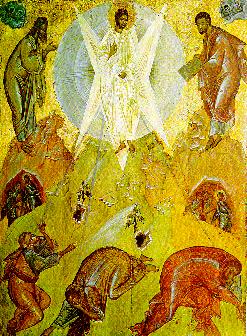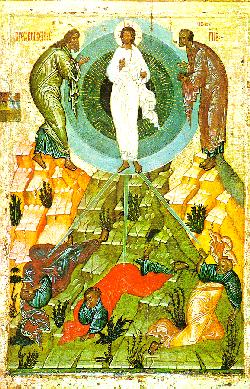
Theophanes the Greek, late 14th century.
Tretyakov Gallery, Moscow, 184 x 134 cm.

 This icon's subject is the Transfiguration of Jesus, in which the glory of God came upon Him and was seen by three of the apostles:
This icon's subject is the Transfiguration of Jesus, in which the glory of God came upon Him and was seen by three of the apostles:
"And it came to pass about an eight days after these sayings, He took Peter and John and James, and went into a mountain to pray. And as He prayed, the fashion of His countenance was altered, and His raiment was white and glistening. And, behold, there talked with Him two men, which were Moses and Elias: Who appeared in glory, and spake of His decease which He should accomplish at Jerusalem. But Peter and they that were with Him were heavy with sleep: and when they were awake, they saw his glory, and the two men that stood with Him. And it came to pass, as they departed from Him, Peter said unto Jesus, Master, it is good for us to be here: and let us make three tabernacles; one for Moses, and one for Elias, for he knew not what he said. While he thus spoke, there came a cloud, and overshadowed them; and they feared as they entered into the cloud . And there came a voice out of the cloud, saying, This is My beloved Son: hear Him" (KJV, Luke 9:28-35).
Although every part of the picture plane is occupied, the main focus of the icon is on the Transfigured Jesus and on the disciples who are awed by the splendour of His glory. Rays of glory that radiate out from Jesus, who is elevated, seem to relate the apostles to Jesus by means of a triangular composition (Jesus above at the highest point and the apostles below). On Jesus' right is Elijah, and on His left is Moses, holding a tablet. Jesus Himself is holding a scroll, symbolic perhaps of His authority and the fact that He is the Living Word of God. His raiment is a bright whitish color that radiates in several directions almost like a star. Behind Him is a silvery-blue circle permeated with golden shafts of light which probably represents both the cloud and His glory. Because of the compositional focus and the color, Jesus is the central focal point of the painting. While Moses and Elijah are level with Him, they are not presented in a manner that would divert the viewer's attention from Jesus. The colour scheme of the icon helps to express the nature of the Transifguration in that, although the overall background colour are shades of orange, yellow, and black, the light emitted from Jesus is casting a blue-green hue over the apostles who are witnesses of it.
Indeed, the figures of the apostles are in attitudes that show their amazement and reactions to the mightiness of Jesus' glory. On the left and right sides of the icon there are also small scenes which parallel each other and are almost identical. Almost midway between Jesus and the apostles are two caves in which four figures stand, observing the scene; it appears to be Jesus and the three apostles. These scenes represent the ascent and descent of Jesus and the apostles, and are examples of the multiple temporalities that can exist in icons. In the upper left and right corners are two identical scenes of angels (perhaps in clouds). This multiplication of witnesses emphasizes the importance of the Transfiguration and its spiritual meaning. This icon, with its bold, dramatic style and strong sense of movement is an excellent example of Theophanes the Greek's "tense, expressive, and mystical style of painting, an extreme form of Paleologian art." [B.B.]
This description would not be complete without a visual comparison of Theophanes' Transfiguration with two other renderings of the theme. The first, a Novgorodian work of the late 15th century, surprises with its monumental composition and brightness of colors, but, at the same time, shows unmistakable signs of Muscovite influences in the elongated proportions of the figures. The second, on the left, is the work of Andrei Rublev. It was painted in 1405 for the Liturgical Feast Row in the iconostasis of the Annunciation Cathedral in the Moscow Kremlin. As in his Holy Trinity, Rublev discards everything superficial, leaving only the six essential figures, beautifully composed into two groups of three and connected only by the rays of light emanating from the mandorla of Christ. The group at the top reminds us of Rublev's greatest masterpiece by the gentle curvature of the bodies of Elijah and Moses, enveloping, as it were, the central figure of Christ. The soft colors, dominated by the ochre of the background, stand in direct contrast to the bright Novgorodian work and to the rich palette of Theophanes. [A.B.]

